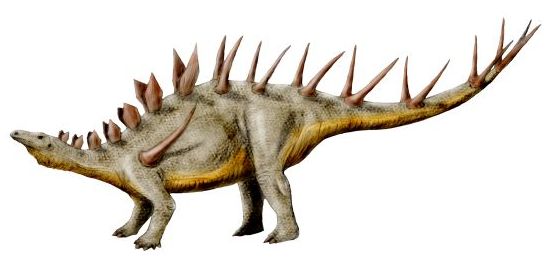
Ready to learn about the pointy-spiked dinosaur called the Kentrosaurus? This dinosaur fact sheet about Kentrosaurus is free to download as a printable PDF document.
What does the name Kentrosaurus mean?
Kentrosaurus translates to “sharp point” or “prickle” lizard. This name was given to it by paleontologist Edwin Hennig because of the sharp spikes found on its tail and the rest of it body.
What family was the Kentrosaurus part of?
The Kentrosaurus is part of the Stegosauridae family. It is a family of dinosaurs that were herbivores and walked on all four legs.
What did the Kentrosaurus eat?
The Kentrosaurus was an herbivore, believed to have existed mostly on low-level vegetation and other prehistoric plant life. When on all fours, the Kentrosaurus was able to eat vegetation up to 1.7 meters tall, but it is theorized that it could reach up on its hind legs to reach higher vegetation in the trees.
When and where did the Kentrosaurus live?
The Kentrosaurus lived in what is now Tanzania in the Late Jurassic period, around 152 million years ago.
How big was the Kentrosaurus?
It could grow up to around 1.7 m (5.6 ft) tall, 4.5 m (15 ft) long and weigh up to 1 to 1.5 metric tons.
When were the first remains of a Kentrosaurus found?
The first remains of a Kentrosaurus were found by the German Tendaguru Expedition in 1909. It was recognized as belonging to the stegosaur family by Werner Janensch in 1910. It was also described by German paleontologist Edwin Hennig in 1915, who coined the Kentrosaurus name.
What are some unique features of the Kentrosaurus?
One of the most distinctive features of the Kentrosaurus is the sharp spikes found on its tail, particularly the direction of these spikes. Most spikes found on other dinosaurs in the Stegosaurus family run almost parallel to each other, while the Kentrosaurus spikes run in different directions along its tail. At the front of the tail, the spikes point backward, in the middle part of the tail the spikes are almost vertical and towards the end of the tail, the spikes are hook-shaped.
What are other interesting facts about the Kentrosaurus?
Dr. Heinrich Mallison of Tübingen University theorizes that the Kentrosaurus could swing its tail in a 180-degree arc and create enough force to crack a human skull.
Get more fact sheets at http://dinocoloring.com/dinofacts
